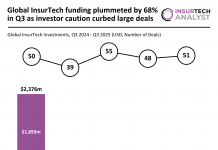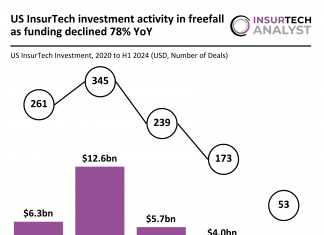Health insurance plays a critical role in safeguarding individuals and families from the financial burdens of medical expenses, offering essential coverage and peace of mind during times of illness or injury. Traditionally, the industry relied on complex and rigid models, often burdened by lengthy paperwork, slow claims processing, and fragmented communication. However, the health insurance market is projected to reach a remarkable $2.38tn in gross written premiums by 2024, according to Statista. This comes amidst a significant shift towards digital platforms and telemedicine services.
Outdated systems are now being removed and replaced by innovative solutions that streamline processes, enhance accessibility, and personalise care. As these advancements reshape the topography of the landscape, they promise to address long-standing inefficiencies and better meet the evolving needs of today’s consumers, marking a pivotal shift towards a more dynamic and responsive industry.
InsurTech Analyst‘s Harry Slade sat down with a pair of industry experts to discuss this InsurTech revolution that is hastily changing the face of health insurance.
The evolution of health insurance
Before the advent of InsurTech, the health insurance system was characterised by cumbersome processes and inefficiencies for both consumers and providers.
Policyholders navigated a labyrinth of forms and claims, often facing long wait times for approvals and reimbursements.
Insurance companies grappled with outdated systems, leading to delays and errors in processing. Communication was predominantly via mail or telephone, which further slowed down the resolution of issues.
The lack of real-time data and digital integration made it difficult to tailor policies to individual needs or manage risks effectively.
As a result, both providers and consumers experienced significant frustrations, from billing disputes to coverage ambiguities, highlighting the urgent need for technological advancements in the industry.
Efrat Marmur – VP Marketing at Air Doctor explained, “Before the rise of InsurTech, the health insurance industry operated on traditional models that were often complex, rigid, and slow to adapt. Policies were largely paper based, making things like claims processing time-consuming and prone to errors. Plus, the lack of digital tools meant that communication between insurers, healthcare providers, and policyholders was often fragmented. This led to inefficiencies and frustrations for consumers, who faced long wait times for reimbursements and limited transparency in their coverage. The industry struggled with key challenges like a lack of personalised care options, minimal consumer engagement, and a cumbersome claims process. These issues left many policyholders frustrated and dissatisfied, setting the stage for disruption.”
How InsurTech solutions are revolutionising the industry
According to Statista, digital transformation has gained significant momentum in the healthcare sector in recent years. Global spending on these initiatives has exceeded $1.3tn, with an impressive annual growth rate of 10.4%.
This underscores the trend of technology taking over and transforming the health insurance sector. But how exactly is this happening?
Vitali Yurkevich, CEO of Symfa commented, “The healthcare industry is undergoing significant digital transformation. From electronic health records (EHRs) and medical wearables to telemedicine, the integration of these innovations is driving greater access, convenience, and efficiency.
“Health insurance is mirroring these advancements. Recently, there has been a wave in the use of technology in the health insurance industry, with companies leveraging it to streamline processes, improve customer experience, and reduce costs.
To achieve this, Symfa is harnessing cutting-edge technologies, such as artificial intelligence (AI) and machine learning (ML), to transform the claims processing landscape. Rather than simply automating routine tasks, Symfa’s innovative approach is designed to enhance both accuracy and efficiency in the system.
Their AI-powered solutions categorise claims based on factors like type, location, and payout amounts, allowing insurers to quickly pinpoint similar cases and draw on historical data for faster resolutions.
This streamlined process not only accelerates claims management but also significantly boosts customer satisfaction by reducing wait times and improving outcomes.
“Another emerging trend worth mentioning is the use of machine learning for health insurance fraud detection. Traditional rule-based systems cannot compare with AI and ML’s ability to offer predictive insights and recognise complex fraud patterns,” said Yurkevich. “To help our clients stay on top of health insurance fraud, we deliver AI-powered solutions that can detect suspicious patterns and inconsistencies in real time, predict fraud risks using historical data, and analyse claims documents by cross-referencing data and flagging anomalies that could indicate fraud.”
Digital platforms and apps have significantly enhanced the customer experience, simplifying how policyholders manage their plans, file claims, and access healthcare services.
These tools offer a more seamless, user-friendly approach, reducing the complexities traditionally associated with insurance processes.
Air Doctor’s Marmur explained, “Telemedicine services, which gained significant traction during the COVID-19 pandemic, allow patients to consult with doctors remotely, reducing the need for in-person visits and lowering costs.
“While AI-driven analytics are being used to personalise insurance offerings, assess risk more accurately, and improve underwriting processes.
“In addition, solutions like the easy-to-use Air Doctor app are transforming how travellers access healthcare abroad, ensuring seamless and stress-free travel experiences by connecting them to a global network of trusted, local doctors. These innovations are driving a paradigm shift towards customer-centric, efficient, and transparent insurance models. The result? A more responsive, accessible, and cost-effective health insurance landscape that’s better equipped to meet modern consumer needs.”
Emerging trends
Amidst this changing face of the sector, several key trends are emerging that will likely shape the future of health insurance over the next decade.
One of the most significant trends is the increasing integration of artificial intelligence (AI) and machine learning (ML) to enhance both efficiency and personalisation in the industry.
AI is revolutionising risk assessment, enabling insurers to offer more tailored coverage plans. Air Doctor’s Marmur noted, “The increasing adoption of AI and machine learning will continue to refine risk assessment, enabling insurers to provide more personalised and dynamic offerings.” This shift toward personalisation ensures that policyholders receive coverage suited to their unique needs, leading to more efficient and cost-effective healthcare solutions.
Another major development is the push toward smarter claims management and fraud detection.
Traditional claims processing systems have long been criticised for being cumbersome and error-prone, leading to delays and higher operational costs.
Symfa’s Yurkevich remarked, “Our AI-driven solutions categorise claims by type, location, payout amount, etc., enabling insurers to quickly identify similar cases and provide resolutions based on past experiences. This ultimately leads to more efficient claims management and improved customer satisfaction.”
As AI-driven solutions continue to refine processes, reduce costs, and improve customer engagement, the health insurance industry is moving towards a future that is more accessible, personalised, and transparent.
These innovations, combined with the rise of telemedicine, wearable technology, and automated underwriting, are setting the stage for a more dynamic, consumer-focused insurance landscape.
Those insurers who embrace these emerging trends are well-positioned to lead the industry in the years to come.
Those who fail to adapt will be left behind, amidst the changing face of health insurance.
Copyright © 2024 InsurTech Analyst
Investors
The following investor(s) were tagged in this article.










